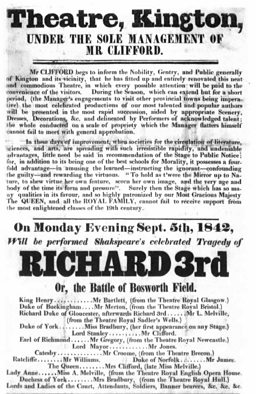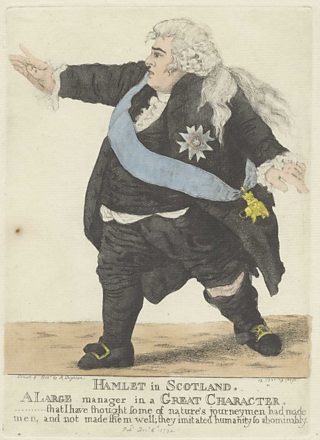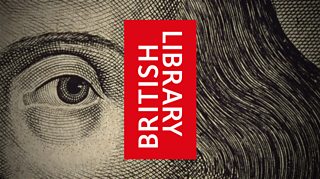A theatre fit for a Queen
Take a comfortable, new theatre, add a fabulous production (Richard III) by a talented author (William Shakespeare) and a great cast. Sprinkle on a bit of stardust in the way of costumes and scenery. But is it enough? How about reminding readers that the stage is “one of the best schools for Morality”? Even Queen Victoria approved, she was amused and enlightened. If it passed muster with the monarch, then how could the people of this rural area resist… especially given their connection with the famous son of strolling players.
-
![]()
Much ado near me
Hear more Shakespeare stories on BBC Hereford & Worcester
-
![]()
Shakespeare Festival 2016
The BBC celebrates the genius of the bard

The Shakespearean actor Stephen Kemble was born in this Herefordshire market town of Kington.

With a cast from a range of regional theatres and London, it seems hastily assembled, a little like a scratch performance of a musical work today.
Kemble was best known during his acting days for the part of Falstaff, before he became one of the most successful theatre managers of the 18th century English stage - establishing himself in Newcastle-upon-Tyne by the close of the century.
In this playbill some twenty years after Kemble’s death, we see a fellow theatre manager back in his home town of Kington, trying his very best to draw audiences into his newly-refurbished theatre.
The playbill represents Kington theatre manager Mr Clifford’s 'pitch' for his newly renovated and 'commodious', theatre staging Richard III in 1842.
With a cast from a range of regional theatres and London, it seems hastily assembled, a little like a scratch performance of a musical work today.
The season is short because this touring company has 'an imperative… to visit other provincial towns'. But the entertainment on offer is top-notch both in the choice of plays and players, some of whom feature from various Theatre Royals across the country – including Kemble’s Newcastle.
The moral probity and respectability of the venture is emphasized as a suitable pursuit for leisure hours – theatre going is so respectable that even the Queen and the Royal Family patronise the theatre.
Queen Victoria had been on the throne for five years, been married and had given birth to two of her nine children. She loved the theatre and during her reign lots of theatres were built. However her tastes ran mainly to lighter comedies and melodramas.
The young Queen found Hamlet difficult to understand, and deplored King Lear’s madness. However she made an exception for the play featured on this playbill, Richard III, which she spoke of as a 'fine, heart-stirring play'. No doubt Mr Clifford, the manager of the theatre in Kington would agree.
About Shakespeare on Tour
From the moment they were written through to the present day, Shakespeare’s plays have continued to enthral and inspire audiences. They’ve been performed in venues big and small – including inns, private houses and emerging provincial theatres.

BBC English Regions is building a digital picture which tracks some of the many iconic moments across the country as we follow the ‘explosion’ in the performance of The Bard’s plays, from his own lifetime to recent times.
Drawing on fascinating new research from Records of Early English Drama (REED), plus the British Library's extensive collection of playbills, as well as expertise from De Montfort University and the Arts and Humanities Research Council, Shakespeare on Tour is a unique timeline of iconic moments of those performances, starting with his own troupe of actors, to highlights from more recent times. Listen out for stories on Shakespeare’s legacy on your BBC Local Radio station from Monday 21 March, 2016.
You never know - you might find evidence of Shakespeare’s footsteps close to home…
Craig Henderson, BBC English Regions
-
![]()
Shakespeare Lives
The nation’s greatest performing arts institutions mark 400 years since the Bard's death
Related Links
Shakespeare on Tour: Around Hereford and Worcestershire
-
![]()
The fear of spreading disease is bad news for many travelling performers
Many towns and cities, including Worcester, laid down strict controls
-
![]()
Famous child actor plays at Ledbury
Are these young child actors really talented, or are they victims of exploitation?
-
![]()
A horse! A horse! My kingdom for a horse!
King Richard III's horse White Surrey is the star of the show
Shakespeare on Tour: Around the country
-
![]()
Ira Aldridge
Ira Aldridge - the first black Shakespearean actor
-
![]()
Blossoming at the Rose Theatre
Shakespeare, budding playwright and actor, at the Rose Theatre from the spring of 1592
-
![]()
Will Kemp dance finished in Norwich
Why did Will Kemp, Shakespeare's former clown, dance from London to Norwich?
-
![]()
London's Female Romeo
Charlotte Cushman, the American actress who took Victorian London by storm










